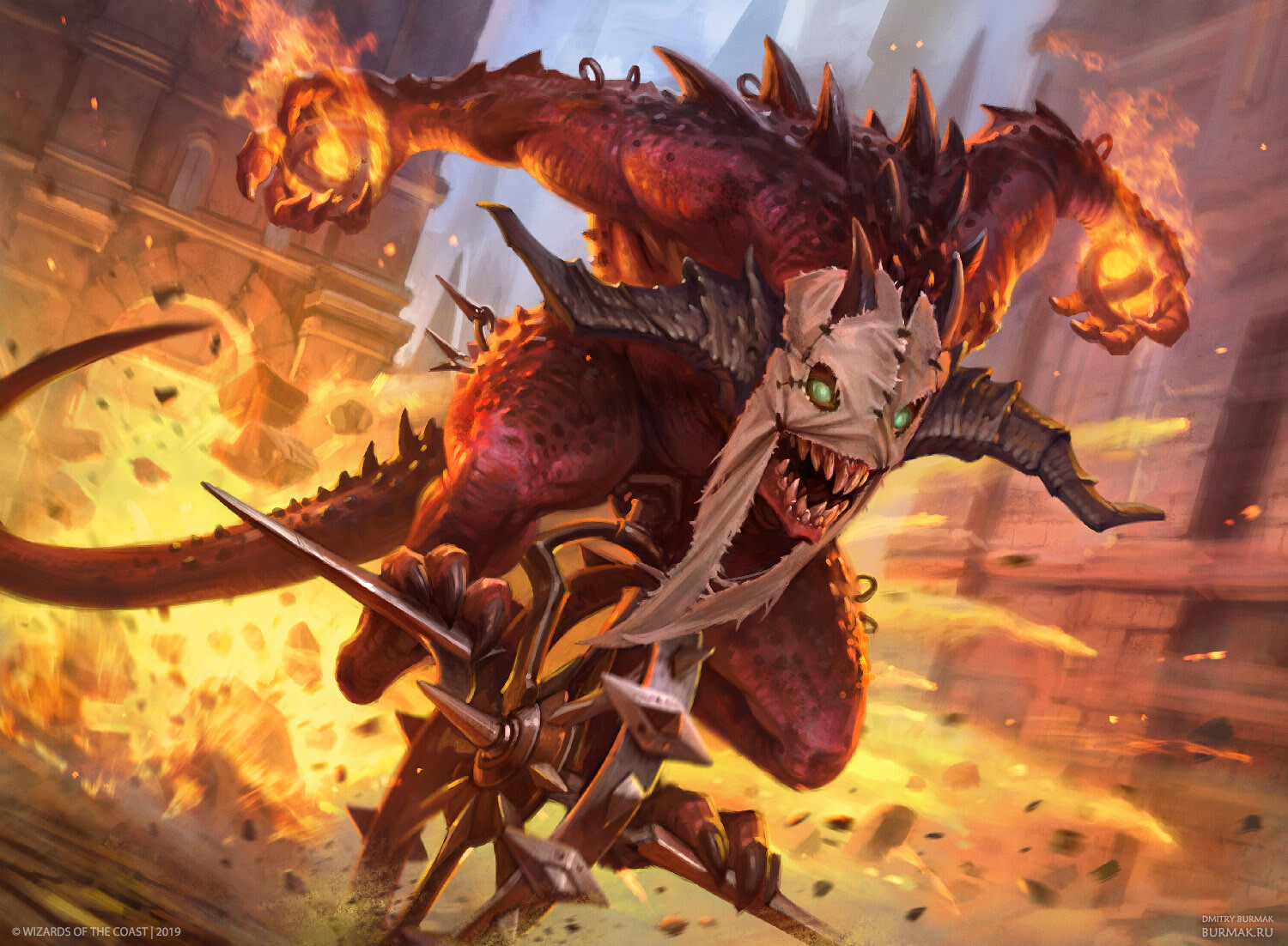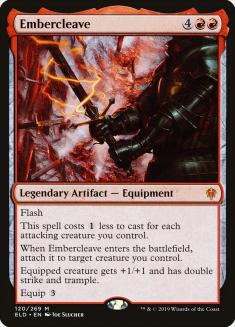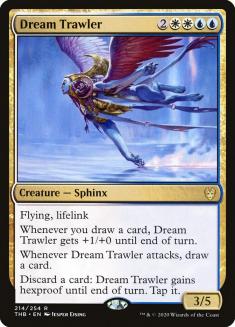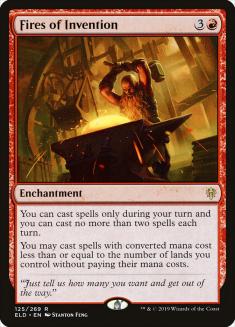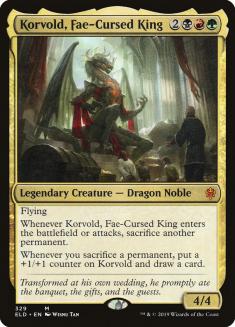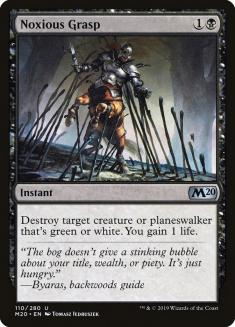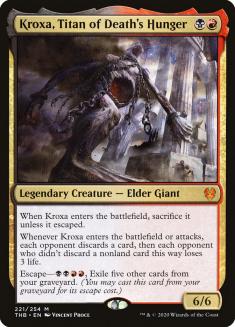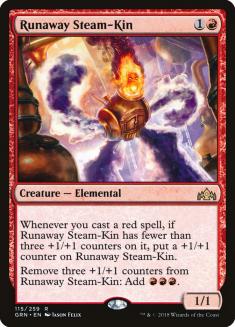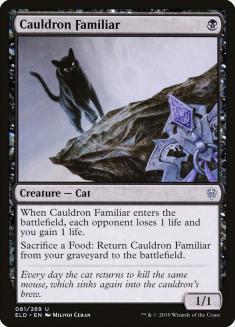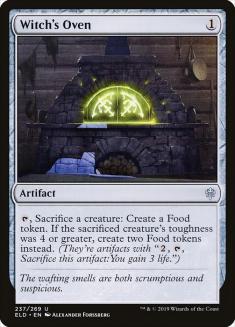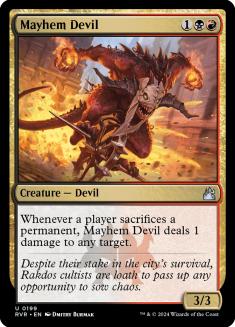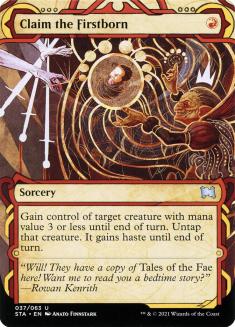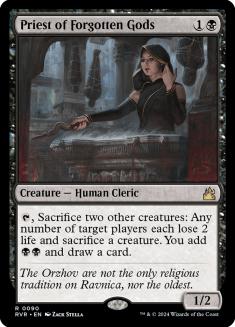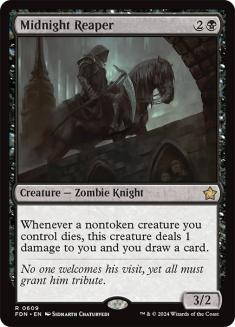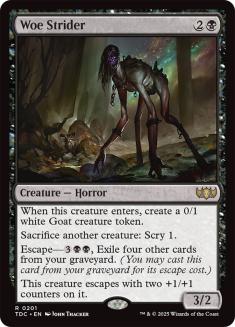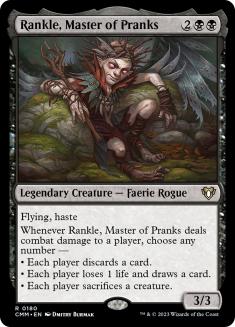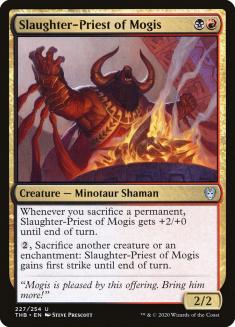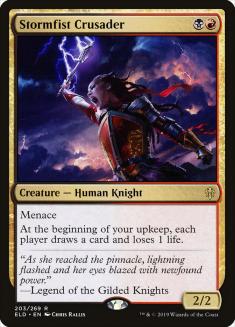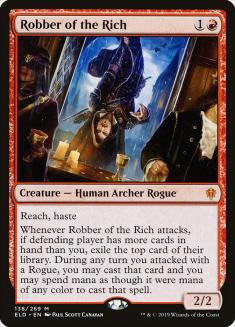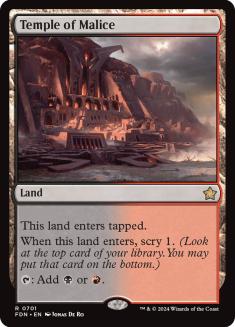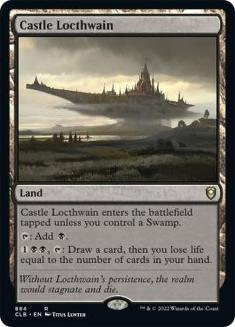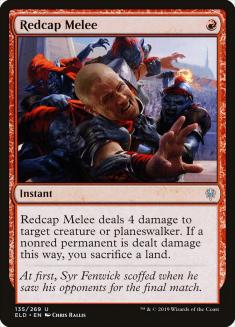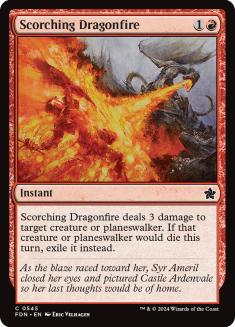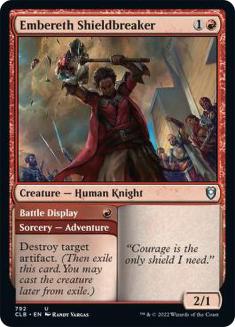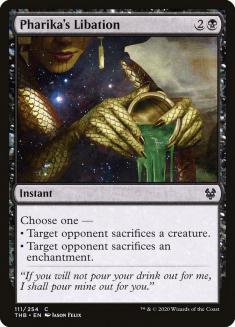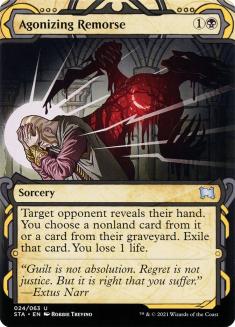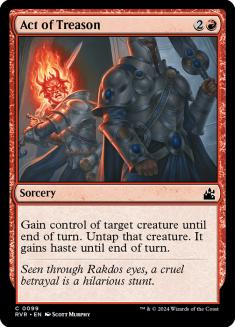In the interest of full disclosure, here is where I see Rakdos Sacrifice in the Theros Beyond Death Standard metagame.
Rakdos Sacrifice is certainly good enough to be Tier 1 or Tier 1.5. Every single matchup is competitive, with the green midrange matchups being in the good category and the more blue- or red-centric decks being closer or at worst slightly unfavorable.
If my life were on the line, I’m unsure I would register Rakdos Sacrifice in an event. It’s much more likely I would register one of the three egregiously game-ending cards in the format: Embercleave, Dream Trawler, or Fires of Invention. While Rakdos Sacrifice is good enough, I’m unsure it has the absolute highest expected win percentage when compared to decks with a free win bonus.
But Rakdos Sacrifice is by far the most fun deck in the format. It’s all the best parts of Magic decision making: resource control, “Who’s The Beatdown” role assessment, properly counting out damage over turns, learning to time your plays against their expected haymaker turns – all without crossing into the raw actions-per-minute territory the way Trail of Crumbs Sacrifice decks can.
If you overlap the circles of “certainly good enough to be high-tier” and “more fun than everything else,” you will find me in the middle just jamming match after match with Rakdos Sacrifice.
Rakdos Versus Jund
I have a ton of respect for Jund Sacrifice. When I mentioned egregiously game-ending cards, Korvold, Fae-Cursed King falls right below that category. It actually costs mana, and about half the time your opponent has a one-turn window to kill it and not be completely dead.
But Jund Sacrifice has a huge difference of approach compared to Rakdos Sacrifice. My comment on the various Sacrifice decks last week:
“If you want to sort the good lists from the bad, focus on which ones get stuck at the three-drops and which ones play games over and under that.”
Jund takes the over and Rakdos takes the under. Jund wants to be casting one-shot game-ending five-drops and six-drops, but all of those cards are green. While Rakdos Sacrifice does play a lot of three-drops, the focus should be on loading up the one-drop and two-drop slots with impactful cards that allow you to apply pressure. When your opponent whiffs on early opposition they should get run over, and when they do fight back you should be able to use your positioning to leverage engines and pull ahead on resources.
If I wanted to make one argument in favor of Rakdos Sacrifice over Jund, it would be dodging the hate cards. Even with Veil of Summer banned, Standard has been heavily defined by the Core Set 2020 anti-enemy-color cycle.
Jund Sacrifice runs more expensive cards into Aether Gust and it’s vulnerable to Noxious Grasp. Rakdos Sacrifice always trades at near-parity for these spells, and sometimes wins games against Aether Gust without giving its opponent a relevant target to use it on. Rakdos is just inherently better against the best sideboard cards in the format than Jund.
Kroxa Is the Titan in the Room
The biggest split between the various Rakdos Sacrifice lists is the inclusion of Kroxa, Titan of Death’s Hunger. While Kroxa is a very powerful card, I don’t think it has a place in Standard Rakdos Sacrifice.
Kroxa isn’t good against Mono-Red Aggro. It’s just a lone 6/6 in terms of stabilizing you, and any swing it provides is more than eroded by the momentum you give up setting it up.
Kroxa might be one of the most vulnerable cards to Aether Gust. While you end up ahead a card if they Aether Gust it when you escape it, what have you really accomplished? You spent six mana on a Blightning? When is the next time you will get five other cards in your graveyard to escape Kroxa?
Kroxa is also a liability against all of the base-Simic decks. Not only does it let them escape their own Titan sooner, it forces you to play their game on their scale. You don’t have a favorable matchup against Bant Midrange because you outclass Nissa, Who Shakes the World heads-up; you beat them by getting under them and being able to leverage their spells costing five mana.
In the head to head, Kroxa also directly loses to Uro, Titan of Nature’s Wrath. Even if both abilities trigger the same number of times, the Uro player ends up with extra cards in their graveyard from it. Every time Kroxa trades with Uro, the Uro player is ready to recast their Titan and the Kroxa player is playing graveyard catch-up.
The one spot Kroxa would serve a good purpose is the Jeskai Fires matchup, where chipping away at their resources and presenting a body big enough to battle Cavalier of Flame really mitigates their gameplan.
But that’s just one matchup against the entire format, and out of a deck that already has good threats that avoid Elspeth Conquers Death. Don’t play Kroxa. Your win rate and your wallet will thank you.
Filling the Slots
While I originally pulled it from a Preliminary 5-0 result, most of the Rakdos Sacrifice list I’ve been playing originates with Raphael Levy.
Creatures (29)
- 3 Midnight Reaper
- 2 Gutterbones
- 4 Priest of Forgotten Gods
- 4 Dreadhorde Butcher
- 4 Mayhem Devil
- 2 Rankle, Master of Pranks
- 4 Cauldron Familiar
- 3 Woe Strider
- 3 Slaughter-Priest of Mogis
Lands (24)
Spells (7)

For gameplay tips, I would just hop back to this wonderful article by Emma Handy. I want to talk about why all these cards have made the cut and why others haven’t.
The core Sacrifice archetype engine is Cauldron Familiar, Witch’s Oven, and Mayhem Devil, and I’ve found that to be non-negotiable. Mayhem Devil is one of your most important paths to snowballing a game in your favor, and it can’t do that without the Witch’s Oven pieces.
As long as people are trying to cast Hydroid Krasis and Uro, Titan of Nature’s Wrath, Claim the Firstborn also makes the cut. It is also quite effective against Temur Adventures’s three-drop Adventure creatures, but just reasonable against Mono-Red Aggro since it is slightly conditional.
Claim the Firstborn also supports Priest of Forgotten Gods, and I’ve yet to be unhappy with this card. Lining an activation up with Dream Trawler is one of your more important plays, the green midrange decks struggle against it, and I’m willing to play all four since extra copies are reasonable fodder for the first one.
The last card I don’t consider negotiable is Dreadhorde Butcher. Rakdos Sacrifice is a deck of aligning resources and leveraging early pressure, and that is everything Dreadhorde Butcher does. It’s a two-for-one against Mono-Red Aggro, it’s a must-answer early threat for Azorius Control, and in every matchup a Turn 2 Dreadhorde Butcher quickly puts your opponent into a life total range where Cauldron Familiar and Mayhem Devil threaten to close them out.
I’ll start the list of debatable cards with the three-drop slot I called out as a choke point.
Midnight Reaper is amazing. When you get a small engine going it convincingly pulls you ahead, and when you are solidly the beatdown it insulates you from Shatter the Sky and other sweepers. You don’t play four because the second copy is only relevant if the first dies.
Woe Strider is merely fine. It provides a way to spin up Mayhem Devil or Slaughter-Priest of Mogis when you don’t have Witch’s Oven, and it provides another route to grinding value with a touch of escape. But Woe Strider is low-impact without support and I can easily see trimming down to one or two copies.
Rankle, Master of Pranks is just a great card and the fact that your deck is set up to maximize the mutual sacrifice is gravy. If you’re wondering what to do with Rankle, I almost always use the discard ability, use the sacrifice ability when it is obvious, and am very tactical with the card draw based on hand sizes and life totals.
Having an excess of one-drops is great in this deck. Every play you make that sticks on the battlefield is a critical resource for later sacrifices, and one-drops ensure you make the most of your mana every turn. But I’ve tried increasing the number of Gutterbones in the deck and it doesn’t pan out. The card has huge diminishing returns in multiples, but more importantly it doesn’t do anything by itself. It costs one and chips in damage and value, which is enough to see play, but that’s it. I wouldn’t be opposed to trying Knight of the Ebon Legion in this slot just on raw rate.
Two-drops also help with this curve filling and people have been experimenting with a lot of the options out there. Whatever you choose needs to be aggressively slanted and a good rate, so Orzhov Enforcer and Mire Triton are not in the picture.
Slaughter-Priest of Mogis often attacks for six to ten damage, especially with Fabled Passage pumping it. The downside is that it is uniquely vulnerable to interaction as a red 2/2, and it is oddly worse in multiples. While it would seem like multiple Priests produce multiple huge attackers, drawing multiples often disrupts the sacrifice fodder-to-sacrifice payoff balance Slaughter-Priest demands.
I’m unsure where I sit on Stormfist Crusader. You can always find stuff to do with extra cards, but I rarely find myself choked on options. On the other hand, I know my opponents all have more powerful cards to draw and I don’t want to give them more shots at those.
If you wanted to experiment further, I would look at Robber of the Rich. Robber can be cast early for full value, provide immediate damage, and threaten a burst of unique effects later on. The only issue might be finding room for multiples to ensure you have Rogues.
Enters-the-battlefield-tapped lands are a huge liability with your tight curve. You need 24 lands to ensure your curve and color, but these three value lands are about all you can afford.
Sideboarding
VS Mono-Red Aggro
Out:
In:
The Mono-Red Aggro matchup is very dynamic. You can turn the corner to kill them more quickly than you would expect, but also want to take almost every opportunity to clear their creatures to minimize the impact of Embercleave. Your Cauldron Familiar + Witch’s Oven hands are great starts to a clean win, often because they turn any Mayhem Devil you draw into an immediate rout. On the subject of Witch’s Oven, don’t forget you can use it to fizzle a Stomp and make sure to time your activations well.
After sideboarding, both decks will get better at making efficient exchanges. Slaughter-Priest of Mogis is inherently committal and dies to Stomp and Redcap Melee, Gutterbones is low-impact and blocks few of their attackers, and Rankle is just expensive. Midnight Reaper is actually a great way to pull ahead in an attrition game, but if you don’t have Cauldron Familiar, it’s a life total liability. You want one or two of the card, but have to trim.
On the flip side, you want Embereth Shieldbreaker to answer the re-equip of Embercleave even if you handle the initial attack and casting it as a 2/1 body is fine in a pinch. Your sideboard also gives you more clean answers to Anax, Hardened in the Forge that don’t leave your opponent with Satyrs, which is huge to keep Embercleave clunky.
VS Azorius Control
Out:
In:
This entire matchup revolves around Dream Trawler and to a lesser degree Archon of Sun’s Grace. Their planeswalkers are annoying and should be attacked down, but you will keep performing game actions and only Dream Trawler lets them lock in being ahead.
In addition to the five answers you sideboard in, you have Priest of Forgotten Gods and Rankle, Master of Pranks as ways to handle Dream Trawler. I try to save Priest as a card I cast after I would have forced a Shatter the Sky but right before they deploy Dream Trawler. Also, time your Agonizing Remorse properly to maximize the odds it takes something that matters but minimize the odds it runs into Absorb.
All of these being sacrifices makes mopping up their stray bodies important. Aim Mayhem Devils that way. You can also use Mayhem Devil to send two pings at Dream Trawler before attacking with Rankle, meaning it dies if they block and it gets sacrificed if they discard a card and tap it.
Beyond that, just apply good pressure and good anti-control practices. Keep a close eye on the metagame to know whether to bias towards playing around or into Shatter the Sky. Figure out some way to time your stuff around Elspeth Conquers Death, because I know I’m still horrible at that. It’s a grindy fight, but you are in it.
VS Jeskai Fires
Out:
In:
Jeskai Fires is going to be your toughest matchup, and as it increases in popularity I have added a second Act of Treason and a third Pharika’s Libation to my deck. A third Agonizing Remorse might be coming soon.
Much like Azorius Control, their creatures are the cards that matter, but Fires of Invention often doesn’t give you a main-phase window to answer them the way Dream Trawler does. Unlike Azorius Control, there isn’t a ton you can do to change your gameplan. You just curve out, hope they don’t have Deafening Clarion plus Fires of Invention plus the threats, and see what happens. If you hit hard enough and their first threat turn doesn’t gain life, often Act of Treason can end the game.
Note I’m trimming Slaughter-Priest of Mogis against Aether Gusts even if it races well, something that will pop up a lot. Again, Stomp also impacts that card and the timing of your Witch’s Oven activations.
VS Temur Adventures
Out:
In:
Temur Adventures does exactly two things that matter against you: trigger Lucky Clover and stick a large blocker. Your sideboard plan consists of cards that interact well against those.
The precise number of Claim the Firstborn you want is up in the air since it works against Lovestruck Beast and Bonecrusher Giant. One of the creatures being trimmed might be better than the second remaining copy of Claim, or better than Act of Treason if you notice Beanstalk Giant heading to the sideboard after Game 1.
If the Stomp versus Witch’s Oven interactions were important before, they are even more important here. I keep saying this because it’s so easy to shortcut and give your opponent a free card if you aren’t constantly vigilant.
VS Bant, Sultai, and Other Green Midrange
Out:
In:
Regardless of how they construct their deck, they’re going to be light on something. Threats, answers, whatever. Hit them with some light discard, and their deck is naturally pre-disposed to folding to yours.
Normally these decks just have cheap things as big threats, but if you see more expensive cards, feel free to swap out Claim the Firstborn for Act of Treason.
VS Rakdos Sacrifice
Out:
In:
Keep Mayhem Devil off the battlefield at all costs. The secondary concerns are Witch’s Oven and Midnight Reaper, but Mayhem Devil not only upsizes their engine, it shuts off yours.
While it seems like Priest of Forgotten Gods would be horrible against a deck with sacrifice fodder, you’re leaning more on the card as a way to churn through plays and damage than as removal.
Sadly you can’t afford Agonizing Demise even if it handles the best cards. Spending two mana to fall behind is a huge cost in a very grinding and battlefield-leveraging matchup.

